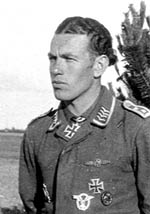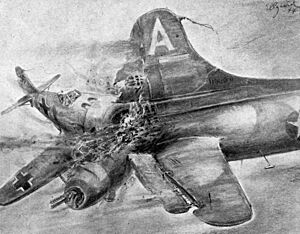Willi Reschke facts for kids
Quick facts for kids
Willi Reschke
|
|
|---|---|

Willi Reschke
|
|
| Born | 3 February 1922 Mühlow, Prussia, Weimar Republic |
| Died | 5 July 2017 (aged 95) |
| Allegiance | |
| Service/ |
|
| Years of service | 1941–1945 |
| Rank | Oberfeldwebel (sergeant) |
| Unit | JG 302 JG 301 |
| Battles/wars |
See battles
|
| Awards | Knight's Cross of the Iron Cross |
Willi Reschke (born February 3, 1922 – died July 5, 2017) was a skilled pilot who flew for Germany during World War II. He was known as a "flying ace" because he shot down 27 enemy aircraft in 70 missions. He also received the Knight's Cross of the Iron Cross, a very high award for bravery.
In 1999, Reschke wrote a book about his experiences during the war. It was published in English in 2005. The book shared his stories about flying different planes, including the special Focke-Wulf Ta 152 fighter. This plane was designed to fly very high in the sky.
Contents
Early Life and Pilot Training
Willi Reschke was born on February 3, 1922, in a place called Mühlow. Today, this area is known as Miłów in western Poland. Close by, in Guben, there was a flight school. This school sparked Reschke's interest in becoming a pilot.
In February 1940, he decided to join the German Air Force, known as the Luftwaffe. After passing his medical checkup, he began his basic training on February 4, 1941. This training took place in Königsberg in der Neumark, which is now Chojna, Poland.
Reschke started his pilot training in the spring of 1942. On April 6, 1943, he continued his flight lessons in Neiße (now Nysa, Poland). There, he learned to fly several types of planes, including the Klemm Kl 25 and the Arado Ar 66. He focused on flying in groups, flying long distances, and doing cool tricks in the air. He also studied navigation in the classroom.
He finished his flight training on June 27, 1943, and received his pilot's badge. Later, in October 1943, Reschke joined a fighter pilot school in Zerbst for more advanced training. In June 1944, he went to a special training unit for fighter pilots who would fight on the Western Front. After 21 practice flights, he was sent to a real combat unit.
World War II Missions
World War II in Europe began on September 1, 1939, when German forces entered Poland. On June 20, 1944, Sergeant Reschke arrived in Vienna. From there, he was sent to an airfield where the 1st Group of Jagdgeschwader 302 (JG 302), a fighter wing, was based.
Reschke was assigned to the 1st Squadron of JG 302. At this time, the group flew Messerschmitt Bf 109 G-6 planes. Reschke flew his first combat mission on June 26. His plane was damaged by enemy fighters, but he managed to land safely. That day, American bombers were attacking a factory in Austria.
On July 2, American bombers attacked Budapest. Reschke's unit took off to defend the city. He claimed his first two victories by shooting down two American B-24 bombers southwest of Budapest. During this fight, his plane was hit, and he had to make an emergency landing.
A few days later, on July 7, Reschke shot down another B-24 bomber. This time, his guns stopped working, so he rammed the bomber with his plane. After the collision, he safely parachuted out of his damaged fighter. By the end of August 1944, Reschke had claimed 13 aerial victories.
Defending Germany
In August 1944, Reschke's unit, I. Gruppe of JG 302, was renamed III. Gruppe of Jagdgeschwader 301 (JG 301). By the end of September, they received new planes, the Focke-Wulf Fw 190 A-8. They were now fighting in the "Defense of the Reich," which meant defending Germany itself.
Reschke claimed his first victory with the Fw 190 on November 21, shooting down a B-17 bomber. On December 24, 1944, the American Air Force launched its biggest attack of the war. Reschke shot down two more bombers that day. On January 1, 1945, he shot down another B-17, but his plane was hit again, and he had to parachute out near Gardelegen.
Flying the Ta 152
On January 27, 1945, Reschke's unit received a new, advanced plane: the Focke-Wulf Ta 152 H-0. They got eleven of these planes at an airfield near Cottbus. The pilots quickly learned how to fly this new aircraft.
Reschke first flew the Ta 152 in combat on March 2. That day, American bombers were targeting oil refineries. Twelve Ta 152s took off, but they accidentally came under attack from other German planes that didn't recognize the new Ta 152s.
The unit was supposed to have 35 Ta 152s, but they never reached that number. So, the remaining pilots and their Ta 152s were moved to the headquarters unit of JG 301. Reschke joined this unit on March 13.
On April 14, Reschke and two other pilots were sent to stop British Hawker Tempest fighters that were attacking a railway yard. He shot down one Tempest, and its pilot was killed. On April 20, Sergeant Reschke received the Knight's Cross of the Iron Cross, a very high military award.
Reschke claimed his last two victories of the war on April 24, when he shot down two Soviet Yakovlev Yak-9 fighters near Berlin. He said the Yak-9 was no match for the Ta 152. All the remaining Ta 152s were later given to British forces. Reschke's last plane was tested by a British pilot and then scrapped.
Willi Reschke passed away in July 2017 at the age of 95.
Awards and Recognition
Willi Reschke received several important awards for his service during World War II:
- Aviator badge (June 27, 1943)
- Iron Cross (1939)
- 2nd Class
- 1st Class
- Wound Badge (1939) in Black
- German Cross in Gold on March 13, 1945
- Knight's Cross of the Iron Cross on April 20, 1945
Images for kids





